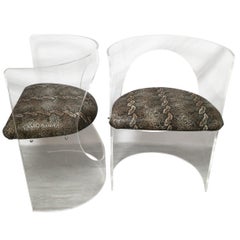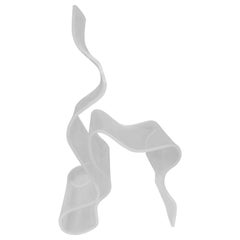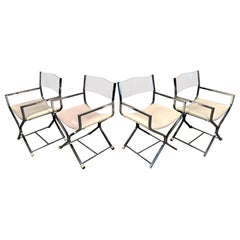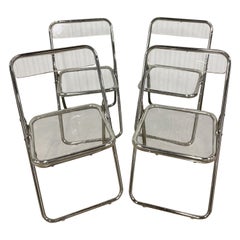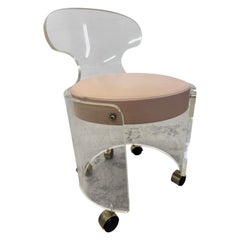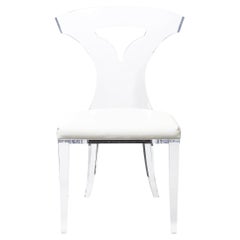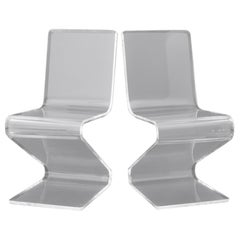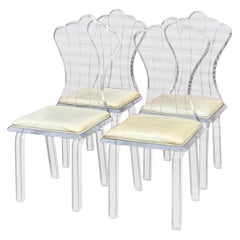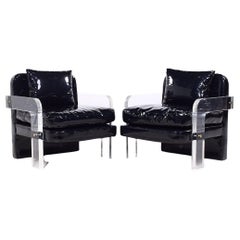Mid Century Lucite Chair
Vintage 1960s American Mid-Century Modern Chairs
Lucite
Mid-20th Century French Mid-Century Modern Side Chairs
Lucite, Plexiglass
Mid-20th Century Mid-Century Modern Chairs
Lucite
20th Century Mid-Century Modern Chairs
Chrome
Late 20th Century Unknown Mid-Century Modern Chairs
Fabric, Lucite
20th Century American Mid-Century Modern Chairs
Leather, Lucite
20th Century Mid-Century Modern Side Chairs
Lucite
Mid-20th Century American Post-Modern Chairs
Upholstery, Lucite
Vintage 1970s American Mid-Century Modern Lounge Chairs
Upholstery, Lucite
Mid-20th Century American Mid-Century Modern Chairs
Metal
Vintage 1950s Mid-Century Modern Chairs
Lucite
20th Century American Mid-Century Modern Chairs
Leather, Lucite
Vintage 1970s American Mid-Century Modern Lounge Chairs
Metal
Vintage 1970s American Mid-Century Modern Lounge Chairs
Fabric, Lucite, Wood
Late 20th Century Unknown Mid-Century Modern Chairs
Acrylic, Lucite
Vintage 1970s American Mid-Century Modern Side Chairs
Lucite
Mid-20th Century Mid-Century Modern Office Chairs and Desk Chairs
Chrome
Vintage 1960s Mid-Century Modern Lounge Chairs
Fabric, Lucite
Mid-20th Century Unknown Mid-Century Modern Dining Room Chairs
Chrome
Mid-20th Century Mid-Century Modern Chairs
Leather, Acrylic, Lucite
Mid-20th Century American Mid-Century Modern Dining Room Chairs
Lucite
Vintage 1970s American Mid-Century Modern Side Chairs
Lucite
Mid-20th Century American Mid-Century Modern Lounge Chairs
Lucite
Vintage 1970s American Mid-Century Modern Side Chairs
Lucite
Mid-20th Century Mid-Century Modern Office Chairs and Desk Chairs
Chrome
Vintage 1980s American Mid-Century Modern Dining Room Chairs
Metal
Late 20th Century Unknown Mid-Century Modern Side Chairs
Upholstery, Lucite
Mid-20th Century American Mid-Century Modern Chairs
Chrome
20th Century American Mid-Century Modern Side Chairs
Lucite
Vintage 1970s American Mid-Century Modern Lounge Chairs
Upholstery, Lucite
Vintage 1970s American Mid-Century Modern Side Chairs
Chrome
Mid-20th Century Mid-Century Modern Swivel Chairs
Aluminum
Vintage 1970s Mid-Century Modern Dining Room Chairs
Chrome
Vintage 1970s American Mid-Century Modern Side Chairs
Lucite
Vintage 1970s Mid-Century Modern Dining Room Chairs
Chrome
Vintage 1970s Mid-Century Modern Side Chairs
Fabric, Lucite
Vintage 1960s Italian Mid-Century Modern Dining Room Chairs
Chrome
Mid-20th Century Italian Mid-Century Modern Chairs
Chrome
Mid-20th Century Italian Mid-Century Modern Chairs
Metal
Mid-20th Century North American Mid-Century Modern Dining Room Chairs
Fabric, Lucite
Vintage 1970s American Mid-Century Modern Dining Room Chairs
Lucite, Fabric
Mid-20th Century American Mid-Century Modern Lounge Chairs
Brass
Mid-20th Century Mid-Century Modern Rocking Chairs
Lucite
Mid-20th Century American Mid-Century Modern Swivel Chairs
Upholstery, Lucite
Mid-20th Century Italian Mid-Century Modern Chairs
Aluminum, Chrome
Vintage 1960s Mid-Century Modern Chairs
21st Century and Contemporary Italian Mid-Century Modern Chairs
Lucite
Mid-20th Century French Mid-Century Modern Chairs
Aluminum
Vintage 1960s American Mid-Century Modern Chairs
Fabric, Lucite
Mid-20th Century American Hollywood Regency Swivel Chairs
Metal
20th Century Mid-Century Modern Chairs
Acrylic, Lucite
Mid-20th Century North American Space Age Swivel Chairs
Metal, Aluminum
Late 20th Century Unknown Mid-Century Modern Chairs
Fabric, Lucite
20th Century American Mid-Century Modern Lounge Chairs
Upholstery, Lucite
Vintage 1960s American Mid-Century Modern Chairs
Brass
Vintage 1970s American Mid-Century Modern Swivel Chairs
Chrome
Vintage 1970s American Mid-Century Modern Lounge Chairs
Acrylic, Naugahyde
Mid-20th Century Italian Mid-Century Modern Chairs
Aluminum, Enamel
- 1
- ...
Mid Century Lucite Chair For Sale on 1stDibs
How Much is a Mid Century Lucite Chair?
A Close Look at Mid-century Modern Furniture
Organically shaped, clean-lined and elegantly simple are three terms that well describe vintage mid-century modern furniture. The style, which emerged primarily in the years following World War II, is characterized by pieces that were conceived and made in an energetic, optimistic spirit by creators who believed that good design was an essential part of good living.
ORIGINS OF MID-CENTURY MODERN FURNITURE DESIGN
- Emerged during the mid-20th century
- Informed by European modernism, Bauhaus, International style, Scandinavian modernism and Frank Lloyd Wright’s architecture
- A heyday of innovation in postwar America
- Experimentation with new ideas, new materials and new forms flourished in Scandinavia, Italy, the former Czechoslovakia and elsewhere in Europe
CHARACTERISTICS OF MID-CENTURY MODERN FURNITURE DESIGN
- Simplicity, organic forms, clean lines
- A blend of neutral and bold Pop art colors
- Use of natural and man-made materials — alluring woods such as teak, rosewood and oak; steel, fiberglass and molded plywood
- Light-filled spaces with colorful upholstery
- Glass walls and an emphasis on the outdoors
- Promotion of functionality
MID-CENTURY MODERN FURNITURE DESIGNERS TO KNOW
- Charles and Ray Eames
- Eero Saarinen
- Milo Baughman
- Florence Knoll
- Harry Bertoia
- Isamu Noguchi
- George Nelson
- Danish modernists Hans Wegner and Arne Jacobsen, whose emphasis on natural materials and craftsmanship influenced American designers and vice versa
ICONIC MID-CENTURY MODERN FURNITURE DESIGNS
- Eames lounge chair
- Nelson daybed
- Florence Knoll sofa
- Egg chair
- Womb chair
- Noguchi coffee table
- Barcelona chair
VINTAGE MID-CENTURY MODERN FURNITURE ON 1STDIBS
The mid-century modern era saw leagues of postwar American architects and designers animated by new ideas and new technology. The lean, functionalist International-style architecture of Le Corbusier and Bauhaus eminences Ludwig Mies van der Rohe and Walter Gropius had been promoted in the United States during the 1930s by Philip Johnson and others. New building techniques, such as “post-and-beam” construction, allowed the International-style schemes to be realized on a small scale in open-plan houses with long walls of glass.
Materials developed for wartime use became available for domestic goods and were incorporated into mid-century modern furniture designs. Charles and Ray Eames and Eero Saarinen, who had experimented extensively with molded plywood, eagerly embraced fiberglass for pieces such as the La Chaise and the Womb chair, respectively.
Architect, writer and designer George Nelson created with his team shades for the Bubble lamp using a new translucent polymer skin and, as design director at Herman Miller, recruited the Eameses, Alexander Girard and others for projects at the legendary Michigan furniture manufacturer.
Harry Bertoia and Isamu Noguchi devised chairs and tables built of wire mesh and wire struts. Materials were repurposed too: The Danish-born designer Jens Risom created a line of chairs using surplus parachute straps for webbed seats and backrests.
The Risom lounge chair was among the first pieces of furniture commissioned and produced by celebrated manufacturer Knoll, a chief influencer in the rise of modern design in the United States, thanks to the work of Florence Knoll, the pioneering architect and designer who made the firm a leader in its field. The seating that Knoll created for office spaces — as well as pieces designed by Florence initially for commercial clients — soon became desirable for the home.
As the demand for casual, uncluttered furnishings grew, more mid-century furniture designers caught the spirit.
Classically oriented creators such as Edward Wormley, house designer for Dunbar Inc., offered such pieces as the sinuous Listen to Me chaise; the British expatriate T.H. Robsjohn-Gibbings switched gears, creating items such as the tiered, biomorphic Mesa table. There were Young Turks such as Paul McCobb, who designed holistic groups of sleek, blond wood furniture, and Milo Baughman, who espoused a West Coast aesthetic in minimalist teak dining tables and lushly upholstered chairs and sofas with angular steel frames.
Generations turn over, and mid-century modern remains arguably the most popular style going. As the collection of vintage mid-century modern chairs, dressers, coffee tables and other furniture for the living room, dining room, bedroom and elsewhere on 1stDibs demonstrates, this period saw one of the most delightful and dramatic flowerings of creativity in design history.
Materials: Plastic Furniture
Arguably the world’s most ubiquitous man-made material, plastic has impacted nearly every industry. In contemporary spaces, new and vintage plastic furniture is quite popular and its use pairs well with a range of design styles.
From the Italian lighting artisans at Fontana Arte to venturesome Scandinavian modernists such as Verner Panton, who created groundbreaking interiors as much as he did seating — see his revolutionary Panton chair — to contemporary multidisciplinary artists like Faye Toogood, furniture designers have been pushing the boundaries of plastic forever.
When The Graduate's Mr. McGuire proclaimed, “There’s a great future in plastics,” it was more than a laugh line. The iconic quote is an allusion both to society’s reliance on and its love affair with plastic. Before the material became an integral part of our lives — used in everything from clothing to storage to beauty and beyond — people relied on earthly elements for manufacturing, a process as time-consuming as it was costly.
Soon after American inventor John Wesley Hyatt created celluloid, which could mimic luxury products like tortoiseshell and ivory, production hit fever pitch, and the floodgates opened for others to explore plastic’s full potential. The material altered the history of design — mid-century modern legends Charles and Ray Eames, Joe Colombo and Eero Saarinen regularly experimented with plastics in the development of tables and chairs, and today plastic furnishings and decorative objects are seen as often indoors as they are outside.
Find vintage plastic lounge chairs, outdoor furniture, lighting and more on 1stDibs.
Finding the Right Seating for You
With entire areas of our homes reserved for “sitting rooms,” the value of quality antique and vintage seating cannot be overstated.
Fortunately, the design of side chairs, armchairs and other lounge furniture — since what were, quite literally, the early perches of our ancestors — has evolved considerably.
Among the earliest standard seating furniture were stools. Egyptian stools, for example, designed for one person with no seat back, were x-shaped and typically folded to be tucked away. These rudimentary chairs informed the design of Greek and Roman stools, all of which were a long way from Sori Yanagi's Butterfly stool or Alvar Aalto's Stool 60. In the 18th century and earlier, seats with backs and armrests were largely reserved for high nobility.
The seating of today is more inclusive but the style and placement of chairs can still make a statement. Antique desk chairs and armchairs designed in the style of Louis XV, which eventually included painted furniture and were often made of rare woods, feature prominently curved legs as well as Chinese themes and varied ornaments. Much like the thrones of fairy tales and the regency, elegant lounges crafted in the Louis XV style convey wealth and prestige. In the kitchen, the dining chair placed at the head of the table is typically reserved for the head of the household or a revered guest.
Of course, with luxurious vintage or antique furnishings, every chair can seem like the best seat in the house. Whether your preference is stretching out on a plush sofa, such as the Serpentine, designed by Vladimir Kagan, or cozying up in a vintage wingback chair, there is likely to be a comfy classic or contemporary gem for you on 1stDibs.
With respect to the latest obsessions in design, cane seating has been cropping up everywhere, from sleek armchairs to lounge chairs, while bouclé fabric, a staple of modern furniture design, can be seen in mid-century modern, Scandinavian modern and Hollywood Regency furniture styles.
Admirers of the sophisticated craftsmanship and dark woods frequently associated with mid-century modern seating can find timeless furnishings in our expansive collection of lounge chairs, dining chairs and other items — whether they’re vintage editions or alluring official reproductions of iconic designs from the likes of Hans Wegner or from Charles and Ray Eames. Shop our inventory of Egg chairs, designed in 1958 by Arne Jacobsen, the Florence Knoll lounge chair and more.
No matter your style, the collection of unique chairs, sofas and other seating on 1stDibs is surely worthy of a standing ovation.
- What is a mid-century chair?1 Answer1stDibs ExpertOctober 19, 2021A mid-century chair is a piece of seating furniture that was designed at any point during the middle of the 20th century. Mid-century modern furniture is characterized by pieces that were conceived and made in an energetic, optimistic spirit by creators who believed that good design was an essential part of good living. The mid-century period provided an excellent opportunity to experiment with both functional and decorative forms. Mid-century modern chairs were made with a variety of natural and synthetic materials, combining leather, wood, and cane with chrome, steel, and plastic. Shop a range of vintage mid-century chairs on 1stDibs today.
- 1stDibs ExpertMay 5, 2023To tell if a chair is mid-century, look for labels and markings that indicate its maker. Then, use trusted online resources to determine when the company was active. A certified appraiser or experienced antiques dealer can be of assistance when dating chairs. Iconic mid-century modern furniture designers include Charles and Ray Eames, Eero Saarinen, Milo Baughman, Florence Knoll, Harry Bertoia and Isamu Noguchi. Find a variety of mid-century modern chairs on 1stDibs.
- 1stDibs ExpertApril 5, 2022Yes, Wassily chairs are indeed considered mid-century modern. Although the chair was initially designed by Marcel Breuer in 1925, it was re-released in the 1960s. Shop a collection of mid-century modern goods from some of the world’s top sellers on 1stDibs.
- 1stDibs ExpertMarch 3, 2023Some iconic chairs from the mid-century modern era include the Egg chair by Arne Jacobson, the La Chaise by Charles and Ray Eames and the Womb chair by Eero Saarinen. With their clean lines, organic shapes and simple details, these chairs reflect some of the key features of the style. Shop a variety of mid-century modern chairs on 1stDibs.
Read More
The 21 Most Popular Mid-Century Modern Chairs
You know the designs, now get the stories about how they came to be.
Mies van der Rohe’s Barcelona Chair Shook Modernism and Charmed Hollywood
The enduring appeal of the Barcelona chair is in the details.
Herman Miller Got Its Start in the Office, but Its Legacy Is in the Home
The brand that turned Charles and Ray Eames, Isamu Noguchi and George Nelson into mid-century household names is just as relevant today as it was six decades ago.
May’s Most Popular Interiors on Instagram
Our feed is filled with the world's most beautiful spaces. See the rooms our followers have deemed the best of the best this month.
April’s Most-Liked Interiors on Instagram
Our feed is filled with the world's most beautiful spaces. See the 10 our followers have deemed the best of the best this month.
See How New York City Designers Experiment on Their Own Homes
There are many lessons to be learned from the lofts, apartments and townhouses of architects and decorators in Manhattan and beyond.
Jeff Andrews Captures Old Hollywood Glamour in His Cinematic Spaces
Having created extravagant homes for reality TV’s biggest stars, the designer is stepping into the spotlight with his first book.
New Orleans’ Lee Ledbetter Makes Design Magic by Mixing Past and Present
The Louisiana-born and -bred architect talks to 1stdibs about the art of making timeless places that matter.
